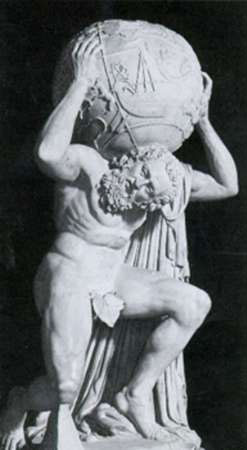Is the key to a lost Greek star catalog engraved on the statue of Atlas carrying the globe on his shoulders? A physics professor took a look at the statue and discovered: "A true example of the discovery of ancient lost knowledge"
Kenneth Chang, New York Times, Haaretz, News and Walla!

Atlas Franzese. "It was among the lost treasures of ancient wisdom - and it was visible to all
Two thousand years after it was written, astronomers still talk about Hipparchus' star catalog - the oldest list of celestial bodies known to science. Hipparchus, who lived in Greece in the second century BC, was perhaps the world's first great astronomer. He calculated the length of the year to the nearest minute (with a deviation of 6.5 minutes). He realized that the Earth's axis oscillates as it rotates. In his star catalog, which was completed in 129 BC, he invented a coordinate system for determining the exact position of each star, and standards for determining the intensity of light. This intensity scale is used by astronomers to this day.
But most of Hipparchus' work is known only from "Kli Shani". No one had seen the catalog with their own eyes for hundreds of years, and it seemed that its contents had been lost forever.
All this until Dr. Bradley Schaefer thought of looking for the catalog on a statue. At the recent American Astronomical Society conference in San Diego, Schaefer, professor of physics at Louisiana State University, reported that the text of Hipparchus' catalog was indeed lost, but something almost as good had been discovered - a representation in pictures of the contents of the catalog. "This is a true example of the discovery of lost ancient knowledge," Schaefer said. It may not exactly be the Da Vinci Code, but as Schaefer described it, it is "a document that is one of the most important lost treasures of ancient wisdom."
Dr. Evan Gingerich, an expert on the history of astronomy at Harvard, described Schaefer's research as "quite amazing". It should be noted that the new discovery was actually visible for hundreds of years.
A two-meter tall statue in the National Archaeological Museum in Naples, Italy depicts the god Atlas kneeling, carrying the earth on his shoulders. Zeus ordered Atlas to support the sky, and on the globe the night sky is depicted as seen from Earth, with representations of different star systems such as Aries, Swan, Hercules, and other animals and human figures representing 41 star systems. The sculpture, known as the "Atlas Franzese", is the oldest visual record of the western star systems. It dates to the Roman period, around 150 AD, and is known to have been copied from an earlier Greek sculpture. "It just sat there and waited," Schaefer said.
The statue corresponds to the year 125 BC
Hipparchus - greater than Ptolemy? The statue provides hints that the representation of the sky depicted in it may have a serious scientific basis. Horizontal lines are drawn on the globe to mark the equator, the circles of Cancer and Capricorn, and the North and South Pole circles. Another circle marks the ecliptic plane, on which the planets revolve around the sun, and verticals drawn on the globe are parallel to the lines of longitude on a map of the Earth.
Some historians have speculated that the statue may have consulted the writings of Ptolemy, who lived about 250 years after Hipparchus, or the writings of Aratus, who described the star systems in a poem about a hundred years before Hipparchus. But it seems that no one, for some reason, mentioned Hipparchus's catalog as a possible source.
Schaefer asked a simple question: In what year were the star systems in the locations described in the Franzese atlas? Due to the oscillation of the Earth's axis, the star systems rotate in the sky in a cycle that is 26 thousand years long.
He noted the places where parts of systems, corresponding to specific stars, intersected with the lines drawn on the globe. For example, the westernmost part of the horn of the Aries system, which is the location of the star Gamma Aries, touches one of the verticals, while the chest of Leo - the location of the star Regulus - stands on the line of the circle of Cancer. Schaefer photographed the statue while on vacation in Naples this year, and based on the photographs he calculated the positions of the other stars. "The stars tell the time", he said, "as if before us is the great hand, moving across the surface of the sky".
Using 70 stars, Schaefer was able to determine that the Franzese atlas most closely matches the sky of the year 125 BC, with a deviation range of 55 years here or there - too early for Ptolemy, too late for Aratus, but in almost perfect coordination with Hipparchus. In addition, Schaefer said, the star systems were located more precisely than could be inferred from oral descriptions - an argument that weakens the possibility that the source was Aratus' poem.
Now that astronomers and historians of science apparently have a direct representation of Hipparchus' star catalog in their possession, they can inquire into questions such as what was the coordinate system he used. The discovery will also provide material for discussing the question, who was the greatest astronomer in ancient times, Hipparchus or Ptolemy?
Some supporters of Hipparchus even claim that Ptolemy's star catalog was essentially a "plagiarism" from Hipparchus. Schaefer said diplomatically that the two scientists were the greatest.
https://www.hayadan.org.il/BuildaGate4/general2/data_card.php?Cat=~~~68639230~~~56&SiteName=hayadan
